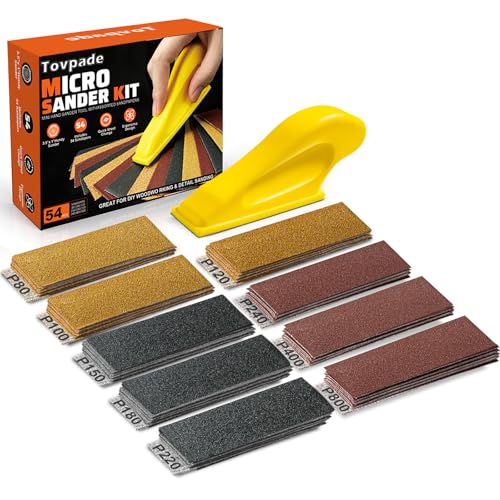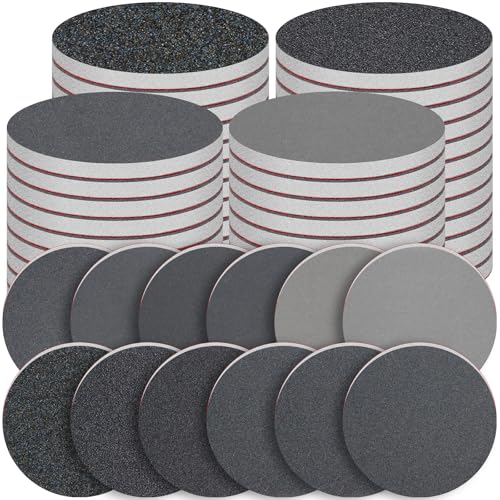Ever looked at a piece of rough wood and wondered how to make it smooth as glass? That’s where sandpaper comes in, but choosing the right kind can feel like a puzzle! It’s easy to get confused by all the different grits and types. You might end up with sandpaper that’s too rough and scratches your project, or too fine and takes forever to do the job. It’s frustrating when you just want your woodworking to look its best.
But don’t worry, we’re here to help! This guide will untangle the mystery of sandpaper for wood. We’ll break down exactly what you need to know so you can confidently pick the perfect sandpaper for any project. By the end, you’ll understand how to make your wood projects super smooth and professional-looking, without any of the guesswork.
So, let’s dive in and discover the secrets to choosing the best sandpaper for your next woodworking adventure!
Our Top 5 Sandpaper For Wood Recommendations at a Glance
| Image | Product | Rating | Links |
|---|---|---|---|
 |
8 Pack Sanding Sponge | 9.1/10 | Check Price |
 |
TOVPADE 54PCS Premium Micro Sander | 9.3/10 | Check Price |
 |
48 Pcs 3 inch Round Sanding Sponge 80-3000 Grit Sandpaper Assortment | 8.8/10 | Check Price |
 |
3M Aluminum Oxide Sandpaper | 8.5/10 | Check Price |
 |
Romeda 8-Pack Sanding Sponge | 9.2/10 | Check Price |
Top 5 Sandpaper For Wood Detailed Reviews
1. 8 Pack Sanding Sponge
Rating: 8.7/10
Tackle any sanding job with this handy 8 Pack Sanding Sponge Assortment. You get eight sanding blocks in four different grits: 60, 80, 120, and 220. That means you have coarse, medium, fine, and superfine options. These sponges are great for wood furniture, drywall, metal, and even fixing glasses. They are washable and reusable, making them a smart choice for many projects.
What We Like:
- You get a good mix of grits to handle different sanding needs.
- The sponges are a perfect size for your hand, making them easy to use for detailed work.
- They are built tough with a flexible sponge and strong grit that won’t fall off.
- It’s easy to tell which grit you’re using because the numbers are printed right on the sponge.
- These sponges work on many surfaces like wood, metal, and drywall, and they’re good for both flat and curved areas.
- You can wash them and use them again, which saves you money.
What Could Be Improved:
- For very large projects, you might need more than eight sponges.
- Some users might prefer a slightly thicker sponge for extra grip.
These sanding sponges offer great value and versatility for your DIY projects. You’ll be ready for any sanding task with this assortment.
2. TOVPADE 54PCS Premium Micro Sander
Rating: 9.3/10
Tackle those tricky sanding jobs with the TOVPADE 54PCS Premium Micro Sander. This handy tool is designed for detailed work, fitting into small spaces and offering great control. It comes with a generous pack of sandpaper, so you’re ready for any project.
What We Like:
- It’s an all-in-one kit with 54 sandpapers in 9 different grits, from rough (80) to super fine (800). This means you have the right sandpaper for almost any task.
- The 3-color grit system makes it super easy to tell coarse, medium, and fine sandpapers apart. No more guessing!
- Changing sandpaper is a breeze thanks to the hook and loop backing. You can swap them out quickly without tools.
- The micro sander block is small (3.5 x 1 inches), making it perfect for getting into tight corners, curves, and grooves.
- It has an ergonomic grip that feels comfortable in your hand, giving you excellent control for precise sanding.
What Could Be Improved:
- While the kit includes many sandpapers, some users might wish for even finer grits beyond 800 for ultra-smooth finishes.
- The small size, while great for details, might not be ideal for sanding larger, flat surfaces quickly.
The TOVPADE Micro Sander is a fantastic choice for anyone needing precision sanding. It’s a versatile and user-friendly tool that helps you achieve great results on your DIY projects.
3. 48 Pcs 3 inch Round Sanding Sponge 80-3000 Grit Sandpaper Assortment
Rating: 9.2/10
Tackle any sanding job with this comprehensive 48-piece set of 3-inch round sanding sponges. From rough shaping to a super-smooth finish, these versatile pads have you covered. They’re designed for comfort, durability, and easy use on a variety of materials, making them a must-have for any workshop or home improvement project.
What We Like:
- Huge Grit Range: You get grits from 80 for heavy work to 3000 for a mirror shine. This means you can do everything from fixing big dents to making furniture look brand new.
- Comfortable to Use: The soft sponge layer makes sanding easier. It soaks up bumps and keeps your hand from getting tired, even during long projects.
- Works Wet or Dry: Use them dry for quick sanding or wet to cut down on dust and make the sponges last longer.
- Easy Hook and Loop System: They attach quickly and securely to most 3-inch sanding tools. Switching between different grits is a breeze.
- Versatile for Many Jobs: These sponges are great for wood, metal, car parts, and even drywall. They are perfect for both pros and DIYers.
- Washable and Reusable: You can wash these sponges and use them again, which saves you money and is better for the environment.
What Could Be Improved:
- Fine Grit Availability: While there are many grits, the very fine grits (like 2000-3000) are grouped together. You might want more distinct grits in that super-fine range for very specific polishing needs.
This sanding sponge set offers fantastic value and performance for a wide range of projects. You’ll be able to achieve professional-looking results with ease.
4. 3M Aluminum Oxide Sandpaper
Rating: 9.0/10
This 3M Aluminum Oxide Sandpaper (9005NA) is a handy tool for many DIY projects. It comes with five sheets, each measuring 9 by 11 inches. You get a mix of grits: 100, 150, and 220. This makes it great for all sorts of jobs. You can use it on paint, wood, and metal.
What We Like:
- It’s super versatile. You can use it by hand, on a sanding block, or even cut it to fit your power sander.
- The aluminum oxide mineral makes it tough and long-lasting.
- You get a good variety of grits in one pack, so you’re ready for different tasks.
- It works well on paint, wood, and metal, making it a true multi-purpose paper.
- It’s durable, so it won’t wear out too quickly.
What Could Be Improved:
- Sometimes, it’s helpful to have more than one sheet of each grit for bigger projects.
- While it’s great for general use, very specific or delicate jobs might need specialized sandpaper.
This sandpaper is a solid choice for most home projects. It gives you the flexibility to tackle different surfaces and materials with ease.
5. Romeda 8-Pack Sanding Sponge
Rating: 8.8/10
Tackle your DIY projects with ease using the Romeda 8-Pack Sanding Sponge. This versatile set provides a range of grits for smoothing and finishing various surfaces. From rough beginnings to a polished shine, these sponges are designed to help you achieve professional results right at home.
What We Like:
- Assorted Grits for Every Job: You get eight sanding sponges with four different grits (60, 80, 120, and 220). This means you have the right grit for everything from removing rough material to creating a super smooth finish.
- Durable and High-Quality: These sponges are made from tough, high-density sponge material. They are flexible and resist tearing, so the sanding grit stays put, even during tough jobs.
- Works on Many Surfaces: Use them for woodworking, furniture, metal, drywall, and even priming. They are great for smoothing out wood filler and preparing surfaces for paint.
- Washable and Reusable: You can use these sponges wet or dry. Rinsing them off makes them ready to use again, saving you money and reducing waste. This also helps keep dust down.
- Color-Coded for Convenience: Each grit has a different color (orange for 60, green for 80, blue for 120, and grey for 220). This makes it super easy to grab the right sponge quickly.
What Could Be Improved:
- The product description doesn’t mention specific dimensions of the sponges, which could be helpful for some users.
The Romeda Sanding Sponges offer a fantastic combination of versatility and durability. They are a smart choice for anyone looking to improve their finishing work.
Choosing the Right Sandpaper for Your Wood Projects
Woodworking projects, big or small, always need sandpaper. It smooths out rough surfaces and gets wood ready for paint or stain. But not all sandpaper is the same. Picking the right one makes your project look great. This guide helps you find the best sandpaper for your needs.
Key Features to Look For
When you shop for sandpaper, a few things matter a lot.
Grit Size: The Roughness of the Sandpaper
Grit size is the most important feature. It tells you how rough or fine the sandpaper is.
- Coarse Grit (20-60 grit): This is for removing a lot of wood quickly. Use it for rough shaping or removing old paint.
- Medium Grit (80-120 grit): This is good for general sanding. It smooths out marks from coarse grit sandpaper.
- Fine Grit (150-220 grit): This makes surfaces smoother. It prepares wood for finishing.
- Very Fine Grit (240-400 grit and higher): This is for polishing. It gives wood a super smooth, almost glassy feel.
Abrasive Material: What Does the Sanding?
The material that does the sanding is called the abrasive. Different materials work best on different woods.
- Aluminum Oxide: This is the most common and a good all-around choice. It works well on most woods and lasts a long time.
- Silicon Carbide: This is sharper and good for hard woods and metal. It wears down faster than aluminum oxide.
- Garnet: This is a softer abrasive. It’s great for fine finishing on soft woods.
Backing Material: What Holds it Together?
The backing is what the abrasive sticks to.
- Paper: This is the cheapest and most common. It works for most jobs.
- Cloth: This is stronger and more flexible. It’s good for sanding curves.
- Fiber: This is very strong. It’s used for heavy-duty sanding.
Bonding Agent: What Sticks the Grit?
This is what holds the abrasive grains to the backing. Resin bonds are strong and last longer. Glue bonds are cheaper but wear out faster.
Factors That Improve or Reduce Quality
Good sandpaper makes your job easier. Bad sandpaper can ruin your project.
Factors That Improve Quality:
- Full Resin Bonding: This makes the sandpaper last longer. The grit stays on the paper better.
- Closed Coat vs. Open Coat:
- Closed Coat: More grit packed onto the surface. This cuts faster and gives a smoother finish.
- Open Coat: Grit is spaced out more. This helps prevent clogging, especially on soft woods or when sanding painted surfaces.
- Uniform Grit Distribution: When the grit is spread evenly, you get a smoother, more consistent result.
Factors That Reduce Quality:
- Poor Bonding: If the grit falls off easily, the sandpaper won’t last.
- Clogging: When sawdust sticks to the sandpaper, it stops sanding effectively. Open-coat sandpaper helps with this.
- Uneven Grit: If the grit is not spread evenly, you’ll see scratch marks.
User Experience and Use Cases
Sandpaper’s job is to make wood smooth. How you use it matters.
Getting Started:
Always start with a grit size appropriate for the job. If wood is very rough, start with a coarse grit. Then, move to finer grits to smooth it out. For example, if you’re taking a rough plank and making it smooth for a table, you might start with 80 grit, then move to 120, then 220.
Sanding Direction:
Always sand with the wood grain. Sanding against the grain leaves ugly scratches that are hard to remove.
Pressure:
Don’t press too hard. Let the sandpaper do the work. Too much pressure can wear out the grit faster.
Use Cases:
- Preparing for Finish: Sanding smooth before applying stain or paint is essential. This helps the finish go on evenly.
- Removing Old Finish: Coarse grits can remove old paint or varnish.
- Shaping Wood: Sandpaper can help round edges or smooth out rough cuts.
- Cleaning Up Mistakes: Sandpaper can fix small errors or rough spots.
Frequently Asked Questions About Sandpaper for Wood
Q: What is grit, and why is it important?
A: Grit is a number that tells you how rough or fine the sandpaper is. Lower numbers (like 60) mean rougher sandpaper that removes wood fast. Higher numbers (like 220) mean finer sandpaper that makes wood smooth.
Q: How do I choose the right grit for my project?
A: Start with a grit that matches the condition of the wood. For rough wood, use a lower grit. For smoothing, use a medium grit. For finishing, use a high grit.
Q: Do I need different sandpaper for different types of wood?
A: Yes, sometimes. Hard woods might need tougher abrasives like aluminum oxide. Soft woods can sometimes clog sandpaper, so an open-coat grit might be better.
Q: What’s the difference between aluminum oxide and silicon carbide sandpaper?
A: Aluminum oxide is very common and lasts a long time on most woods. Silicon carbide is sharper and good for hard woods or metal, but it wears out faster.
Q: When should I use sandpaper with a cloth backing?
A: Cloth-backed sandpaper is stronger and more flexible. It’s good for sanding curved surfaces or for jobs where you need sandpaper that won’t tear easily.
Q: What does “open coat” mean on sandpaper?
A: “Open coat” means there’s more space between the grit particles. This stops the sandpaper from getting clogged with dust, especially when sanding soft woods or painted surfaces.
Q: How can I make my sandpaper last longer?
A: Don’t press too hard. Clean the sandpaper often by brushing off the dust. Store it in a dry place.
Q: Can I use sandpaper to remove paint?
A: Yes, for small jobs or light paint. You’ll need a coarse grit sandpaper (like 60 or 80 grit) for this. For big jobs, other tools might be faster.
Q: Should I always sand in the direction of the wood grain?
A: Absolutely! Sanding against the grain leaves scratches that are very hard to get rid of and will show up when you paint or stain.
Q: What’s the best way to get a super smooth finish on my wood?
A: Start with a medium grit, then move to finer grits. Finish with a very fine grit (220 or higher) to get a smooth, polished surface ready for finishing.
In conclusion, every product has unique features and benefits. We hope this review helps you decide if it meets your needs. An informed choice ensures the best experience.
If you have any questions or feedback, please share them in the comments. Your input helps everyone. Thank you for reading.

